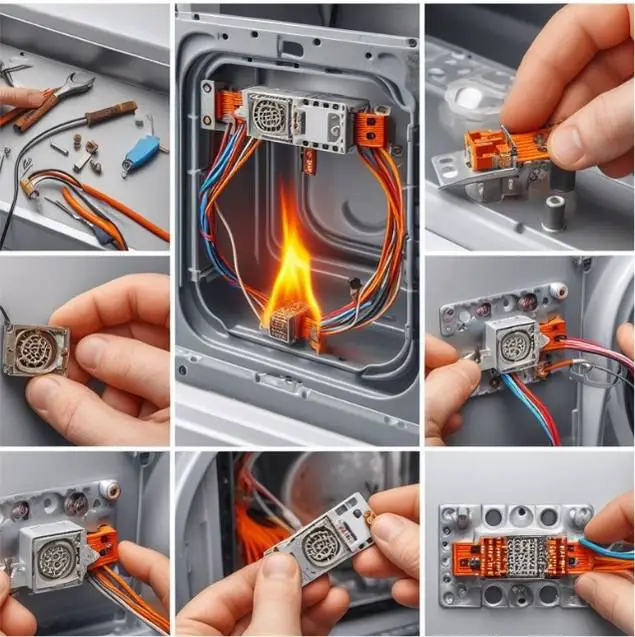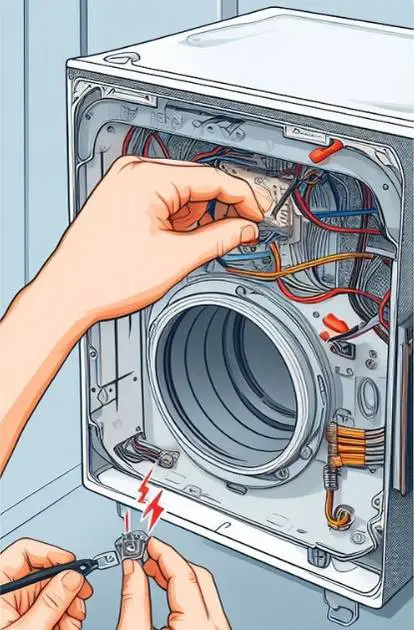Locate the flame sensor by checking the dryer’s user manual. It is usually near the burner, so you will need to take apart the outer panels of your dryer to get to it. Once it’s located (near the igniter or burner), remove it from its assembly. Next, clean the area and install the replacement part by reversing the steps.
Flame sensors are typically made of metal rods that prevent the harmful buildup of gas by ensuring the gas valve is only open when there is an active fire.
In other words, it ensures that there’s a flame present before the gas is released into the dryer.
So, it’s a safety feature that monitors the heat that’s emitted from the igniter. If there’s no flame, the sensor will prevent the flow of gas.
Key Takeaways
- Many dryers, particularly those that run on gas, include a flame sensor as a safety feature.
- Flame sensors are designed to detect the presence of heat/flames, and if it senses the heat, only then it will open the valve.
- A flame sensor consists of a small rod that is typically located near the burner of the dryer. Moreover, the rod is made of material that is sensitive to heat.
- Before replacing the flame sensor it’s highly recommended to get it tested and check if your dryer is still under warranty as this part may be covered.
- Go through the user manual to locate the exact position of the flame sensor.
Table of Contents
What is a flame sensor in a dryer?
A flame sensor is a safety device that is usually installed in gas dryers.
It is a thin metal rod that is located near the burner assembly, usually placed in the path of the igniter’s flames.
The main purpose of the flame sensor is to detect the presence of flames or heat, and if it fails to detect a flame, it will not open the gas valve.
In layman’s terms, the flame sensor senses the heat in the flame and once the temperature reaches a point sufficient enough to light the gas burner, it sends a signal to open the gas valve.
So, flame sensors are an important safety feature in gas dryers, and if they turn faulty, there could be a fire hazard.
Why is a flame sensor important?
A dryer’s flame sensor is an essential safety feature that helps to prevent fires.
The sensor monitors the flames and shuts off the gas supply once the igniter is turned off or it is not producing flames.
So, what this does is it prevents the gas from accumulating or releasing into the dryer when there is no active fire.
If there is a problem with the flame sensor, it can cause the gas valve to stay open even when there is no fire.
This can be extremely dangerous as it can lead to a gas leak and, eventually, a fire.
How does the flame sensor wear out?
In most cases, the flame sensor is made of metal or ceramic, and it can collect a layer of dirt and lint over time.
This buildup can make it hard for the sensor to detect the flame, which can cause the dryer to turn off early or not heat up.
To clean the sensor, remove it from the dryer and use a soft brush or cloth to remove any debris.
How do you test the flame sensor of a dryer?
To test the flame sensor on a dryer, first, make sure that the sensor is clean, and then make use of a multimeter to check for continuity.
Place the points between the two terminals on the sensor with ohm settings.
If there is no continuity, the sensor is defective and should be replaced.
In other words, if the multimeter shows a resistance of zero ohms, then the sensor is working fine. However, if the needle does not move at all, then the sensor is defective and needs to be replaced.
How to replace the flame sensor in a dryer?

If your dryer isn’t igniting due to a faulty flame sensor, it may be time to replace it.
Let’s take a quick look at a detailed step-by-step guide to replacing the flame sensor in a dryer.
Step 1: Unplug your drying machine
Unplug your dryer from the power outlet and move it so you can get to the back and side panels easily.
Do not forget to disconnect the other supplies, such as gas supply pipes and vents.
Step 2: Detach the required panels and the drum
The flame sensor in most cases is located near the igniter in the dryer, and it is hard to find it physically.
Depending on the type and model of your dryer, you will need to locate the flame sensor and remove the appropriate outer or back panels, or both.
The best way to find the exact location of a flame sensor is to look in the user guide.
Once you have figured out the location of the flame sensor, remove the panels (outer/back or both).
In most cases, you will have to remove the back panel of your dryer by removing the screws that hold it in place.
You may also have to remove the dryer’s drum in order to reach the burner assembly and the flame sensor.
Step 3: Remove the faulty flame sensor assembly
Once you’ve found the flame sensor near the burner assembly, remove the wire connector from it carefully.
You can use a Phillips screwdriver to remove the two screws holding the flame sensor in place.
Your flame sensor is now ready to be removed from the dryer.
Step 4: Install the replacement flame sensor
Pull out the old flame sensor and insert the new one in its place carefully.
Make sure to clean the areas around it using a damp cloth.
Reconnect the wire connector to the new flame sensor and screw it in place with the Phillips screwdriver.
Step 5: Reassemble the dryer
Put the back panel back on your dryer and tighten it with the screws.
Next, place the dryer in its original location and plug it back into the power outlet.
Step 6: Run a test cycle for testing
Plug in the dryer and reconnect the required supplies to run a test cycle.

Safety Precautions to follow when dealing with flame sensors in dryer
When working on any gas appliance, including your dryer, safety should always be the top priority.
Here are critical safety precautions to follow before you start replacing the flame sensor:
- Turn Off Gas Supply: Locate the gas shut-off valve for your dryer and make sure it is in the “OFF” position. This step is crucial to prevent any gas leakage during the process.
- Unplug the Dryer: Disconnect the dryer from the power outlet to ensure there is no electrical supply while working on the appliance.
- Ensure Proper Ventilation: Work in a well-ventilated area to prevent the accumulation of gas fumes. If possible, open windows and doors for better airflow.
- Wear Appropriate Safety Gear: When dealing with gas appliances, it’s advisable to wear safety goggles and gloves to protect your eyes and hands.
- Have a Fire Extinguisher On Hand: It’s a good practice to have a fire extinguisher nearby in case of any unexpected incidents.
Troubleshooting a Faulty Flame Sensor

If you suspect that your dryer’s flame sensor is malfunctioning, here are some common symptoms and potential solutions:
Symptoms of a Faulty Flame Sensor
- Dryer Not Heating: If your dryer isn’t producing any heat or taking an unusually long time to dry clothes, a faulty flame sensor may be the culprit.
- Frequent Shut-offs: The dryer might start but then shut off prematurely during the drying cycle, causing inconvenience.
- No Flame Ignition: If the gas burner isn’t igniting, it could be due to a malfunctioning flame sensor.
Potential Solutions
- Clean the Flame Sensor: Over time, the flame sensor can accumulate dirt and lint, hindering its ability to detect the flame. Therefore, it’s important to gently clean it using a soft brush or a cloth.
- Check Wiring Connections: Ensure that the wires connected to the flame sensor are secure and not damaged. Loose or damaged wires can lead to sensor malfunctions.
- Test the Flame Sensor: Use a multimeter to test the flame sensor for continuity. If it shows no continuity, it’s likely defective and should be replaced.
- Inspect Gas Supply: Verify that the gas supply to the dryer is active and there are no obstructions in the gas line.
When to Call a Professional Technician?
While some dryer issues can be resolved by following the steps provided, there are instances when it’s best to seek the expertise of a professional technician:
- Complex Repairs: If the issue goes beyond routine maintenance, such as problems with the gas valve, control board, or electronic components, it’s advisable to consult a professional.
- Gas Line Concerns: If you suspect any issues with the gas line or connections, it’s crucial to contact a certified technician to avoid gas leaks and safety hazards.
- Warranty Coverage: If your dryer is still under warranty, attempting repairs on your own might void the warranty. Consult the manufacturer or authorized service provider for covered repairs.
- Lack of Experience: If you are unsure about any aspect of the repair process or don’t have the necessary tools and expertise, it’s safer to leave it to a qualified technician.
Can you bypass the flame sensor?
You can try cleaning the flame sensor instead of bypassing it.
Bypassing the flame sensor should be done only to see if that fixes the problem temporarily, but is not recommended.
You can try bypassing the sensor by jumpering out 2 of the 3 wires going to it.
But if you bypass a flame sensor, it will not be able to tell if the flame is active or inactive. Therefore, it won’t shut off automatically and will continue to release gas even if the flame is not lit.
This can lead to a dangerous situation where the dryer continues to release gas even if there is no flame.
What is the cost of the flame sensor?
The cost of a flame sensor can vary depending on the brand and model of the dryer. However, on average, a flame sensor costs anywhere between $20 and $50.
How long does a flame sensor in the dryer last?
There are many factors that can affect how long a flame sensor will last in a dryer.
The type of sensor, the quality of the sensor, the usage frequency, and the environment in which the sensor is used can all affect its lifespan.
On average, a flame sensor should last anywhere between 5 and 10 years.
Final Thoughts
It can be tricky to replace the flame sensor in a dryer as the most common problem is locating the sensor in the first place.
Once you know where the sensor is, it’s easy to take it off with a screwdriver.
Before you replace the flame sensor, you need to test it with a multimeter to make sure it is faulty.
This is because the symptoms of a faulty flame sensor can be very deceptive and common.
For example, symptoms of a faulty flame sensor may be similar to those of a faulty heating element or thermal fuse, i.e., the dryer will not heat.
So, always test the flame sensor before replacing it, and also check if your appliance is still under warranty.
If you are lucky enough to have warranty coverage, you may not need to self-troubleshoot.
You May Also Like
- How to replace the moisture sensors in a dryer?
- How to replace the drive belt in a dryer?
- How to replace the Thermostat in a Dryer? (In-depth guide)
- How to replace a thermal fuse on a dryer?
- How To Replace a Dryer Blower Wheel?
- 11 Creative Ideas to Recycle Washer and Dryer Drums
- Can you use a Dryer Drum for a Fire pit?
- How To Replace Dryer Heating Element? (Step-by-Step)
- How to replace the Igniter in a Gas Dryer?
- 14 Reasons Why Your Dryer is Squeaking & Solutions
- What is a Smart Washer and Dryer? (Explained)
- Washer Dryer: 27 Questions Answered
- Why do Korean Homes come with Washers but not Dryers?
- Gas Dryers vs Electric Dryers (Differences Explained)
- Damaged Dryer Vents: 8 signs your dryer vent is damaged
- Dryers & Vents: 20 frequently asked questions
- Why is the dryer not drying clothes?

